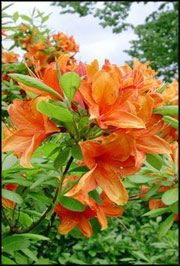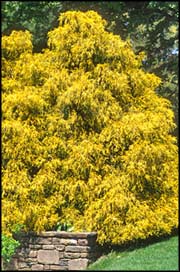
Main
Newsletter Deals
Forum - Outdoor Living
Product Reviews
Arbors
Barbecues and Grills
Bells and Chimes
Lanterns and Torches
Lighting
Outdoor Accents
Outdoor Furniture
Patio Decor
Planters
Feng Shui Tips
Feng Shui Garden
Garden Planning
Vegetable Gardens
Yard and Garden Care
Garden Ponds
Pool and Spa
Water Features
Water Fountains
Decks and Fences
Gazebos
Greenhouses
Shed and Storage
Patio Umbrellas
Birds and Birding
Bird Feeders
Bird Houses
Birdbaths
About ES
Site Map
Contact
Plants for Small Gardens
Almost any plant other than medium-sized or tall trees, or very large shrubs and rampant ground cover can be grown in a small garden. Often, quite large plants are used, but they need to be pruned back regularly to maintain a compact size. Wherever possible, it’s best to choose naturally compact plants that won’t become a nuisance.
Evergreen Trees
If conifers are excluded, there are few evergreen trees suitable for a small garden. Few broad-leaved trees are evergreen in temperate climates, and unfortunately many of those that are, such as the evergreen oak (Quercus Ilex), grow far too large for most gardens. There are some worth searching out, such as Drimys winteri, which is too large for a tiny garden, but not a fast grower. It’s not a good choice for cold areas, however, Hollies (ilex) are really tough and can be trained into a conical or standard tree with a clear trunk. Drimys winteri is an uncommon plant, especially where winters are cold, but it makes an intereting large shrub or small tree with large leathery evergreen leaves and fragrant white flowers in late spring.
Deciduous Trees
It’s a pity to exclude trees from a small garden, but choose those that remain small and have more than one season of interest. Acer Griseum, for example, has a lovely cinnamon bark which looks wonderful in winter sunlight as well as fantastic in autumn color. Many hawthorns (crataegas) make pleasing compact trees for a small garden. For flowering trees, look for those with columnar growth, such as Prunus “Amanogawo Rosea.” “Flore Pleno” is a pretty hawthorne with double pink flowers in late spring. These trees never become very large.
Make a point of visiting gardens in winter, and note which border plants remain evergreen. There are not many of them, but they are invaluable for sustaining interest during the bleak months.
 |
Conifers
Conifers come in many shades of gold and green (some with a hint of blue), as well as various shapes and sizes. The vast majority are evergreen. Unfortunately, most of them grow far too tall for a small garden. Select those with a narrow, columnar growth that will not ultimately become too tall: Some to look for are “Skyrocket: :Hibernica” and “Fastigiata Aurea.” “”Goldcrest” also has a pleasing upright profile as well as bright color. Goldcrest eventually makes a medium sized tree, but has a narrow growth that means it does not take up excessive ground space. Young foliage is a beautiful yellow.
Dwarf Conifers
A visit to any garden center will reveal a bewildering choice of dwarf conifers, but always check on likely size after 10-15 years of growth. Some may remain dwarf and may even be at home in a rock garden; others may grow surprisingly large. Among those that grow shrub-size are “Aura Nana” “Rheingold” and “Filifera Aurea”, “Blue Star” remains low-growing and there are many other ground hugging conifers.
Evergreen Shrubs
You will be spoilt for choice with evergreen shrubs, so decide how large or small you want the plant to grow to reduce your short list. If you have an acidic soil, rhododendrons are a likely choice, but some can grow huge while others are suitable for a rock garden. There are bound to be varieties of appropriate size for your needs. Herbs are also available in many shapes and sizes, but always check that the ones you like are winter-hardy in your area. Heathers are evergreen and they are compact enough for your garden. The winter flowering Erica Carnea varieties are especially useful. Varigiata is a delightfully bright and compact dwarf shrub, but it may suffer or even be killed when winters are cold.
 |
Deciduous Shrubs
The problem with many deciduous shrubs is their short period of interest: flowering sometimes lasting no more than a couple of weeks. To make the best use of space, choose some that have golden or variegated foliage for a longer period of interest, or select those that have early color, like chaenomeles. Which bloom in spring – or that have late season interest such as Cotoneaster Horizontalis with its bright berries and vivid autumn foliage color. Some, such as hydrangeas, also retain their flowers for a long period, and the dead heads also make an interesting winter feature.
Border Plants
All but the largest and tallest or most rampant herbaceous plants are suitable for a small garden, but where space is limited it’s best to concentrate on those that flower early or late, or that look good over long periods and don’t only look good for a week or two in the summer. Lupins look fantastic for a couple of weeks but for the rest of the season offer little interest. Select summer flowers that bloom over a long period, or that have attractive foliage. For early border flowers, doronicums, with their yellow dairy-type flowers, look good, while at the other end of the season schizostylis and varieties and hybrids Sedum spectabile will sustain the color.
Evergreen Border Plants
Make a point of visiting gardens in winter, and note which border plants remain evergreen. There are not many of them, but they are invaluable for sustaining interest during the bleak months.
